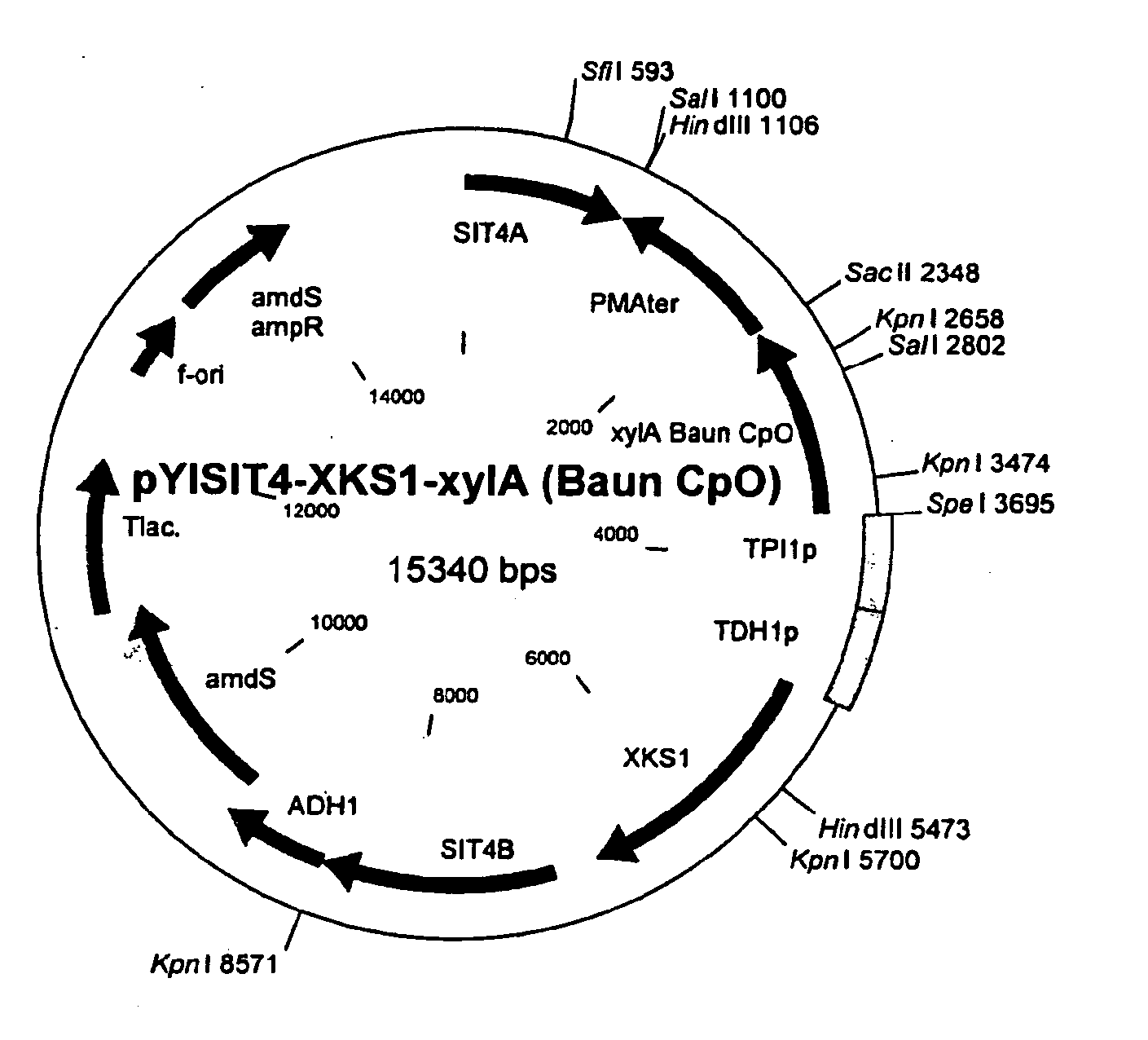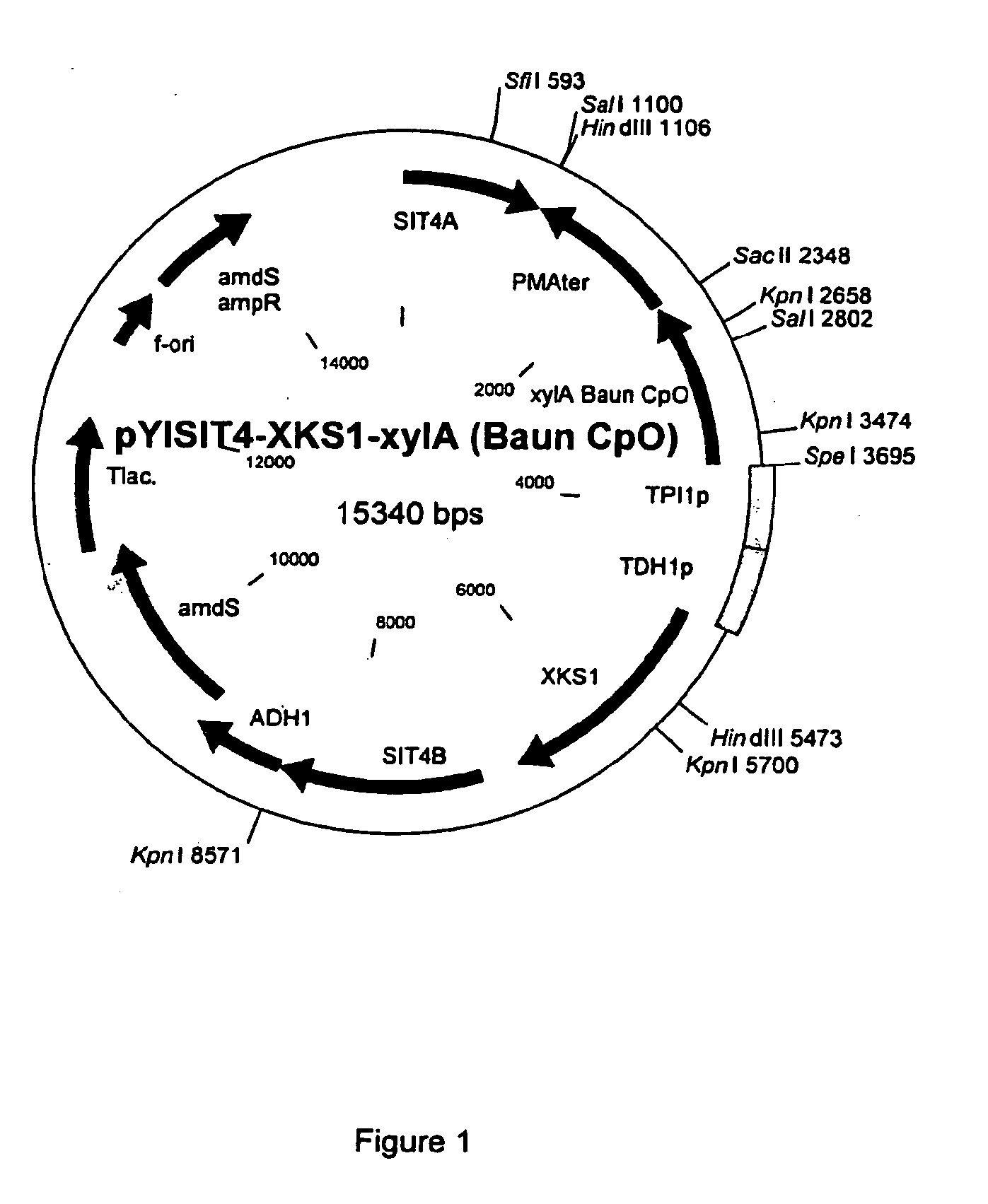Pentose sugar fermenting cell
a pentose sugar and fermenting cell technology, applied in the field of pentose sugar fermenting cell, can solve the problems of high pollution, inability to produce ethanol using xylose as a carbon source, high cost, etc., and achieve the effect of increasing the amount of ethanol
- Summary
- Abstract
- Description
- Claims
- Application Information
AI Technical Summary
Benefits of technology
Problems solved by technology
Method used
Image
Examples
example 1
Expression of Xylose Isomerase from Bacteroides uniformis ATCC 8492 in Saccharomyces cerevisiae
1.1.1 Construction of Xylose Isomerase Expression Vector
[0163]Xylose isomerase [E.C. 4.2.1.2], GenBank accession number AAYH02000036 (SEQ ID NO: 1) from Bacteroides uniformis ATCC 8492 was analysed for the codon usage. The codon use was optimized as described in WO2006 / 077258 and WO2008 / 000632 (SEQ ID NO: 2).
[0164]The gene according to SEQ ID NO: 2 was cloned in front of the TPI1-promoter of S. cerevisiae. In order to prevent potential inefficient expression of the xylose isomerase, the following sequence was placed in front of the coding sequence:
ACTAGTAAAAACACATACATAAACTAAAAATG,
[0165]showing the start codon underlined.
[0166]A SpeI restriction site ACTAGT) was introduced in the strong, constitutive TPI1-promoter, changing the sequence[0167]TCTTGCTTAAATCTATAACTACAAAAAACACATACATAAACTAAAAATG (original TPI1 promoter) into[0168]TCTTGCTTAAATCTATAACTAGTAAAAACACATACATAAACTAAAAATG.
[0169]This allo...
example 2
Growth of Transformed Yeast Strains on Xylose
2.1 Medium Composition
[0174]Growth experiments: Saccharomyces cerevisiae strains are grown on medium having the following composition: 0.67% (w / v) yeast nitrogen base and either glucose, galactose or xylose, or a combination of these substrates (see below). For agar plates the medium is supplemented with 2% (w / v) bacteriological agar.
[0175]Ethanol production: Shake-flask cultivations were performed at 30° C. in a synthetic medium (Verduyn et al., Yeast 8:501-517, 1992). The pH of the medium was adjusted to 6.0 with 2 M KOH prior to sterilisation. For solid synthetic medium, 1.5% of agar was added.
[0176]Pre-cultures were prepared by inoculating 100 ml medium containing the appropriate sugar in a 500-ml shake flask with a frozen stock culture. After incubation at 30° C. in an orbital shaker (200 rpm), this culture was used to inoculate either shake-flask cultures. The synthetic medium for anaerobic cultivation was supplemented with 0.01 g I...
example 3
3.1 Introduction of Four Constitutively Expressed Genes of the Non-Oxidative Pentose Phosphate Pathway
[0179]Saccharomyces cerevisiae BIE104P1, expressing the genes TAL1, TKL1, RKI1 and RPE1 constitutively, was obtained by transforming CEN.PK113-7D (MATa URA3 HIS3 LEU2 TRP1 MAL2-8 SUC2) with plasmid pPWT080 (FIG. 2). To a large extent, plasmid pPWT080 was constructed by using synthetic DNA, synthesized by GeneArt AG (Regensburg, Germany). The sequence of plasmid pPWT080 is set out in SEQ ID 4. In short, plasmid pPWT080 consists of the promoter region of the GRE3-gene, followed by the four PPP-genes TAL1, TKL1, RKI1 and RPE1 under control of strong constitutive promoters, and the 3′ non-coding sequences of the GRE3-gene, as set out in FIG. 2. As selectable markers, the kanMX-gene conferring resistance to G418 and the Aspergillus amdS-gene allowing the transformants to grow in acetamide as sole nitrogen source are present on this plasmid. Upon integration, followed by intramolecular re...
PUM
 Login to View More
Login to View More Abstract
Description
Claims
Application Information
 Login to View More
Login to View More - R&D
- Intellectual Property
- Life Sciences
- Materials
- Tech Scout
- Unparalleled Data Quality
- Higher Quality Content
- 60% Fewer Hallucinations
Browse by: Latest US Patents, China's latest patents, Technical Efficacy Thesaurus, Application Domain, Technology Topic, Popular Technical Reports.
© 2025 PatSnap. All rights reserved.Legal|Privacy policy|Modern Slavery Act Transparency Statement|Sitemap|About US| Contact US: help@patsnap.com



